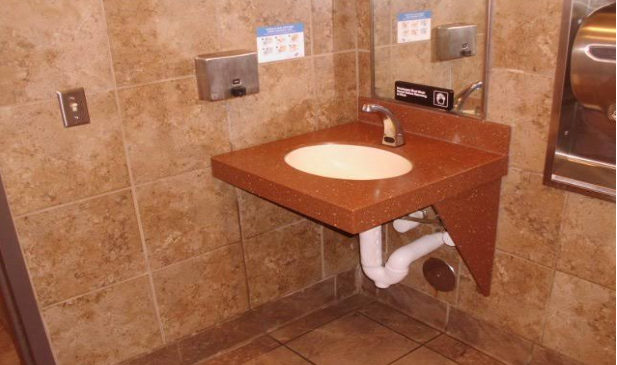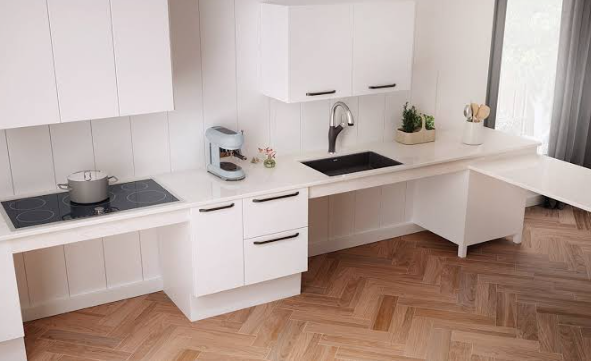
Meeting ADA knee clearance guidelines is vital for ensuring accessibility in various public spaces, from kitchenettes to commuter rail stations. Understanding these requirements can greatly influence the usability of amenities like exercise machines and dining areas, particularly in high-traffic environments. Achieving proper knee clearance enhances functionality and comfort, making spaces welcoming for everyone. Keep reading to discover essential design elements and practical steps for ensuring compliance in your own facilities.

Knee clearance represents a critical element of accessibility requirements set forth by the Americans with Disabilities Act (ADA). It specifically pertains to the space beneath various fixtures, such as plumbing fixtures and countertops, where individuals using mobility aids, like wheelchairs, require adequate room for maneuvering. Identifying locations where knee clearance is essential, including restrooms and public seating areas, ensures compliance with accessibility standards. The ADA outlines minimum measurements for knee clearance, generally suggesting a height of 27 inches and a depth of 25 inches to accommodate users comfortably. Furthermore, proper knee clearance promotes smooth traffic flow by enabling individuals with mobility challenges to navigate spaces effectively, ultimately enhancing their experience within public and private facilities, including those provided by health care providers.
Knee clearance, as outlined in the ADA, encompasses the unobstructed area beneath various structures, ensuring individuals can maneuver comfortably. This concept functions like a precise machine, functioning as a signal to designers that sufficient space is crucial for accessibility. The specifications for knee clearance are a fundamental part of the code of federal regulations, highlighting the importance of creating inclusive environments for all users.
Knee clearance is essential in various public spaces, particularly within buildings where individuals encounter different fixtures. For instance, restroom stalls often require adequate knee space to ensure comfort and ease of movement, while food service counters need to facilitate access for those in wheelchairs. Moreover, pathways must be designed with attention to cross slope and other factors to ensure that users can approach them perpendicularly without obstruction.
In addition, other areas, such as parking zones, also necessitate appropriate knee clearance under car doors to enable passengers using mobility devices to exit or enter vehicles smoothly. Consideration of these factors during the design phase guarantees that walkways remain unobstructed, fostering an inclusive environment for everyone. Such thoughtful design choices contribute to a seamless experience across all public facilities.
The minimum measurements for accessible knee clearance, as specified by the ADA, often dictate a height of 27 inches and a depth of 25 inches. This ensures that individuals using mobility aids, such as wheelchairs, can comfortably approach fixtures, including courtroom seating, restroom lavatories, and even vehicle entrances. Attention to these dimensions is crucial in both public and private spaces, including those where essential items, like toilet paper, are readily available and where passageways can resemble a tunnel that requires compliance with accessibility standards.
Knee clearance plays a vital role in creating an inclusive environment that meets ADA standards. Ensuring adequate space beneath fixtures like accessible toilets, bathtubs, and dining tables enables seamless maneuvering for individuals using mobility devices. Moreover, consideration of knee clearance around escalators and outdoor dining areas enhances accessibility, allowing everyone to navigate public spaces comfortably.
With a solid grasp of knee clearance requirements for ADA compliance, designers can now explore vital elements that ensure proper accessibility. Examining these design features will pave the way for creating spaces that truly accommodate everyone.

Designing for adequate knee clearance involves a multifaceted approach, integrating various elements that can significantly impact accessibility. Architects must consider the materials used in fixtures and surfaces that influence available knee space, ensuring they comply with guidelines established by the Rehabilitation Act of 1973 and the ADA. Existing public areas often require thoughtful modifications to incorporate sufficient knee space without disrupting the overall aesthetic or function. The arrangement of furniture and fixtures within a pedestrian zone plays a critical role in maintaining fluid movement and accessibility for all users. Furthermore, awareness of common design mistakes, such as improper angles and insufficient depth, helps professionals create more inclusive environments that serve everyone, including those navigating courtrooms or dining spaces.
The choice of materials in designing public spaces can significantly influence the adequacy of knee clearance. For instance, surfaces that allow for easy maneuverability along the aisle and provide appropriate toe space can help individuals using mobility aids navigate with greater ease. During a property‘s inspection for a certificate of occupancy, attention must be paid to these materials to ensure they meet ADA compliance standards, enhancing accessibility for all users.
Integrating knee space into existing public areas requires careful evaluation of current layouts and a commitment to maximizing accessibility. For instance, when assessing pathways or road surfaces, it becomes crucial to ensure adequate clearance beneath counters and tables, allowing individuals using mobility aids to maneuver comfortably. Compliance with Section 504 of the Rehabilitation Act mandates that modifications consider elements like the diameter of furniture legs, ensuring they facilitate user access while conforming to established figures in accessibility standards.
Furniture and fixtures significantly impact the availability of knee clearance in public spaces. Proper placement and design of these elements ensure that users can maneuver around obstacles without encountering difficulties. Attention to features such as clear floor space and the incorporation of pictograms can enhance users’ understanding of accessible routes, whether navigating a mezzanine or traversing a street.
| Design Element | Impact on Knee Clearance |
|---|---|
| Furniture Arrangement | Facilitates clear floor space for movement |
| Pictograms | Guides users to accessible features |
| Counter Height | Ensures appropriate knee clearance |
| Fixture Design | Optimizes space around curb areas |
Avoiding common design mistakes related to knee clearance is vital for ensuring ADA compliance in public spaces. Designers must prioritize accessibility in planning layouts, especially around areas like pedestrian crossings and emergency exits, where unobstructed movement is critical. Failing to account for proper knee space can lead to non-compliance during occupancy inspections, ultimately compromising the overall functionality and safety of the environment.
Understanding these design elements is just the beginning. Now, let’s dive into practical steps to assess your space for optimal knee clearance.

Evaluating spaces for knee clearance compliance involves a systematic approach that ensures adherence to ADA standards. Conducting a preliminary knee clearance audit serves as the first step, allowing professionals to assess current designs and identify areas requiring attention, such as access points near vending machines or under countertops. Equipped with appropriate tools for measuring knee clearance accurately, teams can gather critical information about available space. Interpreting ADA guidelines on knee clearance will provide clarity on minimum height and depth requirements that contribute to accessible environments, including considerations for accessible parking. Finally, developing remediation steps for non-compliant spaces can lead to modifications that enhance usability, such as adjusting elements under the roof or ensuring standby power sources are conveniently situated. Addressing these factors, even in fraction-sized increments, cultivates more inclusive public environments.
Conducting a preliminary knee clearance audit requires careful inspection of various facilities, including restrooms and shower areas, to ensure compliance with ADA standards. It is essential to measure the knee space beneath elements like toilet seats and counters, focusing on areas prescribed by guidelines from the Centers for Disease Control and Prevention. Special attention should be given to less common locations, such as basements, where accessibility may often be overlooked, thereby enhancing overall usability for individuals relying on mobility aids.
Proper tools are essential for accurately measuring knee clearance to ensure spaces remain accessible to all users. Utilizing precise measuring devices, such as laser distance meters or rigid measuring tapes, streamlines the evaluation process, allowing professionals to assess clearances under elements like counters and doors effectively. In specialized environments, such as press boxes or prisons, careful attention to detail in knee clearance measurements can significantly enhance the overall accessibility of these facilities.
Interpreting the ADA guidelines on knee clearance requires attention to specific measurements, such as the recommended height and depth. These standards ensure that spaces, including therapy rooms in nursing homes and unisex restrooms, provide sufficient accessibility for all individuals. Facilities must assess their design elements to accommodate mobility devices, particularly in areas where users must navigate narrow lanes or around obstacles like cells.
| Measurement | Recommended Standards |
|---|---|
| Height | 27 inches minimum |
| Depth | 25 inches minimum |
| Location Examples | Therapy rooms, nursing homes, unisex restrooms |
| Application | Clear access in lanes, around cell areas |
Addressing non-compliant spaces requires a strategic approach to achieve ADA compliance. For instance, in a changing room, adjustments may include raising the height of sinks or repositioning fixtures to ensure that patients using mobility aids can access them with ease. In a lobby, adding removable ramps or reallocating furniture may enhance navigation for all visitors.
Having explored the essential steps for knee clearance compliance, it’s time to see real-world applications in action. The following case studies highlight successful implementations that transformed spaces with effective knee clearance solutions.

Examining real-world examples of effective knee clearance implementation provides valuable insights into advancing accessibility in public spaces. By transforming environments through strategic alterations, such as installing curb cuts and ramps, facilities can accommodate individuals using wheelchairs, ensuring seamless navigation across varying topography. Innovative design solutions have emerged, demonstrating how thoughtful planning can create pedestrian-friendly areas that prioritize ease of movement. User feedback plays a pivotal role in understanding the true impact of these changes, highlighting the substantial improvement in experiences for individuals who rely on enhanced knee clearance in their daily lives.
Transformations in public spaces can significantly improve usability for individuals with mobility needs. A recent construction project updated a local community center by incorporating compliant knee clearance areas around bathing and restroom facilities, and optimizing chair placement in dining areas. These adjustments not only meet ADA requirements but also enhance the overall experience for all users.
| Before Transformation | After Transformation |
|---|---|
| Lack of adequate knee space under tables and counters | Enhanced knee clearance allowing for easier maneuvering |
| Inaccessible bathing facilities for wheelchair users | Upgraded bathing areas meeting ADA compliance |
| Fixed chair arrangements obstructing pathways | Flexible chair setups promoting movement and usability |
Innovative design solutions for knee clearance enhance accessibility in a variety of public spaces. Some facilities have responded to the challenge by incorporating features like accessible drinking fountains located at heights that meet building code requirements, ensuring users can approach without obstruction. Additionally, the integration of ramps alongside stairs provides a seamless transition for individuals in physical therapy, allowing for easier navigation from sidewalks to entryways.
User feedback on improved knee clearance reveals significant benefits in public spaces designed with thoughtful dimensions. Individuals facing disabilities express appreciation for greater room to maneuver, facilitating easier access to essential services and amenities. The alignment with ADA law and standards set by organizations like the National Fire Protection Association demonstrates a commitment to inclusivity and safety, enhancing the overall experience for all users.
The next crucial step involves empowering the team with knowledge. Staff training on knee clearance can transform how they approach their designs and interactions.

Training staff on the significance of knee clearance is pivotal in ensuring ADA compliance, particularly regarding facilities used by the public. Education around the requirements set forth by the United States Access Board empowers employees to understand the specific dimensions necessary for accommodating individuals using mobility aids. Implementing best practices in maintaining knee clearance standards not only enhances the safety of public spaces but also reflects a commitment to accessibility in dwelling units and other facilities. Additionally, fostering a culture of accessibility promotes awareness among staff, ensuring they can effectively guide passengers in valet parking areas and other transit points, thereby creating an inclusive environment for all users.
Educating staff on ada knee clearance requirements is fundamental for creating accessible public spaces. Knowledge about specific dimensions for areas such as parking spaces and portable toilets aids in effective compliance. Furthermore, training on the necessity of clear signage and appropriate planning around features like fire alarm systems can significantly enhance accessibility for individuals with visual impairment.
| Aspect | Importance |
|---|---|
| Parking Space | Compliance with dimensions facilitates easier access for users |
| Portable Toilet | Ensures sufficient knee clearance for mobility devices |
| Signage | Guides users to accessible features efficiently |
| Fire Alarm System | Integration of accessibility standards ensures safe evacuation |
| Visual Impairment | Consideration of clear pathways enhances experience for those with disabilities |
Maintaining knee clearance standards requires consistent assessment and adherence to established guidelines. Regular inspections of areas such as bus stops and public restrooms can help identify potential obstructions, ensuring the floor remains clear for effective maneuvering. Furthermore, carpets must meet specific height requirements to enable a smooth transition, with at least a percentage of the space dedicated to unobstructed knee clearance.
Implementing training programs that emphasize these best practices fosters a culture of compliance among staff members, enhancing their ability to maintain accessible environments.
Creating a culture of accessibility in public spaces requires a collective commitment to inclusivity at all levels. By prioritizing the installation of features such as braille signage at gates and ensuring safe paths for individuals with disabilities, facilities can foster environments that respect the needs of all users. Each inch of thoughtful design and strategic planning contributes to a space where everyone feels welcomed and supported.
Staff members play a crucial role in sustaining this culture, as they serve as the first point of contact for visitors. Training them to understand the significance of accessibility enhances their ability to assist individuals navigating the environment effectively, similar to how air traffic control directs safe passage for aircraft. Through designated training sessions, teams can learn to monitor paths and address potential obstacles, ensuring seamless movement for everyone.
As organizations prioritize safety and accessibility, the conversation surrounding knee clearance is rapidly evolving. New advancements and updates to ADA regulations are on the horizon, promising to reshape how spaces accommodate everyone.

Anticipating the future of knee clearance within the context of ADA compliance reveals several noteworthy trends that require attention. As amendments to ADA accessibility guidelines evolve, predictions suggest that more inclusive regulations will influence not just recreational spaces but also the design of dwelling units. Technological advancements will provide innovative solutions to improve compliance, such as automated adjustments in public fountains and fixtures for better accessibility. Moreover, changing demographics, including an aging population and individuals with diverse mobility needs, are likely to prompt a reassessment of existing standards, ensuring that knee clearance remains a priority in creating environments that foster equitable access for all individuals.
Future amendments to ADA regulations are expected to increasingly emphasize knee clearance metrics to accommodate a wider range of users. As the percentile of individuals requiring mobility assistance rises, adjustments in guidelines may necessitate specific parameters regarding the height of grab bars and clearance near walls to ensure optimal accessibility. These changes will likely encourage designers to create inclusive spaces that are more reflective of diverse needs, aiming to address previously overlooked areas in public infrastructure.
Technological advancements are significantly enhancing compliance with knee clearance regulations, specifically in public spaces where mobility challenges are prevalent. Innovations such as adjustable handrails and automatic elevators facilitate better access, allowing individuals to navigate complex environments without hindrance. This proactive approach to design reduces traffic congestion in busy areas, including detention facilities and employment centers, thereby promoting equitable access for all users.
| Technology | Impact on Knee Clearance Compliance |
|---|---|
| Adjustable Handrails | Facilitates customizable support for varying user heights |
| Automatic Elevators | Improves access across multiple levels without barriers |
| Smart Traffic Management | Reduces crowding by optimizing pedestrian flow |
| Innovative Detention Facility Designs | Ensures compliance while enhancing safety and accessibility |
| Employment Center Modifications | Promotes integration of staff and visitors through better access |
As demographics shift towards an aging population, the need for more flexible knee clearance standards will become increasingly evident. Individuals using mobility aids, such as wheelchairs, often require expanded space to navigate areas like van parking spots, bathroom entrances, and urinals efficiently. Additionally, the layout and ratio of accessible features in public facilities, including closet spaces that enable easy access to necessary tools, will need to adapt to ensure comprehensive accessibility for all individuals.
Mastering ADA compliance through effective knee clearance design plays a vital role in ensuring accessibility in public spaces. By adhering to specified measurements and recognizing critical areas requiring adequate knee space, facilities can promote seamless navigation for individuals using mobility aids. Thoughtful design choices and ongoing staff training cultivate an inclusive environment that enhances user experience. Embracing these principles not only fulfills legal obligations but also demonstrates a commitment to supporting all members of the community.

When considering the safety and accessibility of all users in a restroom, sink clearance plays a crucial role. The amount of space around a sink

Building an ADA-compliant kitchen doesn’t have to involve a full renovation. With a few adjustments, you can ensure ADA clearance in your kitchen and make